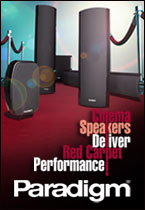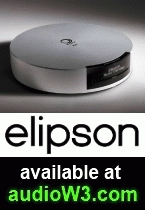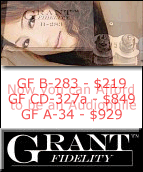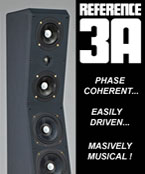
I often have music playing in the background while writing, to sooth some of the street noise. I live near a busy street so sounds like streetcars, cars honking and people’s voices creep into my house, especially when I have some windows open. Although, my windows normally do a good job of isolating outside noise, allowing me to do critical listening when need be. The other day while writing and listening to music, I heard the record skip. As I jolted up to change the track, it occurred to me that I wasn’t listening to my record player but a Magnum Dynalab MD-90 analog solid state FM tuner. I was tuned-in to a college radio program that used record players and their record was skipping. It might be hard to believe but a state-of-the-art tuner can sound almost as good as a turntable. Canadian-based Magnum Dynalab has been in the analogue FM tuner business for over 20 years so it’s no surprise that they know a thing or two about audiophile tuners.
The MD-90 tuner arrived at my house in a standard cardboard shipping box, firmly packed with a power cord, an instruction manual and a Magnum Dynalab SR-100 silver ribbon FM antenna. The black aluminium face of the MD-90 had a retro but attractive and obviously high-end look to it. Most noticeable on the front, are three backlit analog meters labelled multipath, center tune and signal. The multipath meter shows whether or not the same FM signal is being received by your antenna and tuner at two different time intervals. The center tune meter shows the setting of the tuner’s front-end in relation to the station that you are tuning to. Finally, the signal meter indicates the FM station’s signal strength. Below the centre analog meter is a digital display of the frequency which the MD-90 is tuned to. A good-sized flywheel tuning knob sits on the right side of the front panel. Toggle switches for power, mono/stereo, IF band and mute are located on the left. Below the switches, an IR sensor is housed. The MD-90 does not come with a remote, although a matching remote can be purchased separately. A blue LED below the signal meter lights up when a stereo signal is acquired. The back panel of MD-90 houses stereo L/R gold-plated RCA output connectors, an “F” antenna connector and a power cord port.
The SR-100 is an indoor FM antenna that is continuously tuneable via its centre adjustment knob. It can be rotated on its base for best station orientation. The SR-100′s silver ribbon allows the listener to focus on either the main or a strong, reflected signal.
Once set into my audio rack and connected to a tube amplifier and preamp, I flicked the power on. Magnum Dynalab recommends connecting their solid state tuners to tube amplifiers in order to get the best of both tube and solid state worlds. The trio of front meters lit up with an amber glow and the digital display showed the station frequency with a matching amber glow. With a slight twist of the tuning knob, I instantly locked onto a radio station. I jogged down the knob to a local classical station to give the tuner some time to warm up and begin the break in process. After only a few minutes, I realized how pleasant and spacious sounding the MD-90 was. The sound was hard to compare to other tuners.
During the first week that the MD-90 spent at my house, I gave it enough time to settle in as it played quietly in the background. I can’t say there was a huge difference between when I first listened to the tuner and now but I can say that when I turned it up a week later, I was amazed at what I was hearing. The detail and spaciousness of the MD-90 were incredible and the background was extremely quiet. I owned a Magnum Dynalab FT-11 analog FM tuner in the past, so I knew what I could expect from Magnum Dynalab but the MD-90 definitely had an edge over the FT-11 from what I can remember. The MD-90 produced more detail and had a quieter background.
The MD-90 was so detailed in fact, that while surfing through the stations I could tell whether the broadcast was coming from a CD, mp3 or vinyl (which is rare these days). When using a good source, you can definitely hear some pretty amazing details. Even when listening to a live-to-air broadcast, I could hear the compression used to stream back to the broadcast tower from the remote location. I confirmed this with a radio station technician friend, who just happened to be working for this station that same night.
Listening to classical stations, I could easily place instruments and get a sense of depth and space. The sound performance of the MD-90 placed it somewhere between a good quality turntable and mid-range CD player. I did a little experimenting and recorded some radio shows on my computer at various resolutions. When I recorded a DJ show at 16-bit, 44 kHz, it lost some of the frequency range and presence. When I recorded it with a 24-bit, 96 kHz sampling rate, I heard the same kind of realness that the original program had. I am not suggesting that this is an accurate method of testing but rather that a high-end tuner can supersede some of the digital technology. For comparison, digital radio even uses more compression than a CD.
Every song and program that I listened to through the MD-90, graced me with a clean and clear presentation. The tuner had a phenomenal frequency extension. Classical recordings had that top-end sparkle of an orchestra while drum and bass radio shows extended the low-end far deeper than I am accustomed to from radio broadcasts. The sound of the MD-90 was definitely not bleached out, something that solid state components often do. The harmonics were rich, full and comparable to some of the classic tube tuners I have listened to in the last few years. I can only image how much better the tube version of this tuner sounds.
Not surprisingly, with slight adjustments of the tuning dial, the MD-90 allowed me to pick up stations that most other tuners could only dream of. Of course, the SR-100 antenna lent a helping hand with this. Stations that where weak in signal and often drifted from white noise to nothing now came through clear and in full stereo. On more than a few occasions, frequencies previously known to me as white noise came through clean and clear. I was very glad to discover several great, new stations during the time I had the MD-90. The ability of this tuner to hone in and hold a signal was one of its greatest achievements.
Listening to the MD-90 was not like listening to the radio at all. During extended listening sessions, I caught myself thinking “that’s a great CD or record”, forgetting that I was actually listening to live radio. Radio signals can certainly be high fidelity and the MD-90 confirmed that.
If you own a higher-end stereo setup and enjoy listening to the radio, this is one of the finest components that you could add to your system. Considering its performance and build quality, the MD-90 is worth every penny of the $1350 that Magnum Dynalab asks for it. The $35 SR-100 FM antenna is more than affordable and was an essential accessory, at least in my neighbourhood. Depending on where you live, the guys at Magnum Dynalab will suggest the best antenna for your tuner. The MD-90 tuner certainly made it on to my list of near-future audio purchases.
Manufacturer:
Magnum Dynalab
www.magnumdynalab.com
905-791-5888

Price:
MD 90 Tuner: $1350 MSRP
SR-100 Antenna: $35 MSRP
Magnum Dynalab MD 90 Tuner
• Usable sensitivity (mono):
10.3 dBf
• Usable sensitivity (stereo):
11.2 dBf
• 50 dB quieting sensitivity (mono):
13.2 dBf
• 50 dB quieting sensitivity
(stereo): 34.0 dBf
• Capture ratio: 1.5 dB
• Image rejection: 75.0 dB
• Signal to noise ratio (SNR):
75.0 dB
• THD - mono: 0.10%
• THD - stereo: 0.18%
• Stereo separation: 50.0 dB
• AM suppression: 70.0 dB
• SCA rejection: -80.0 dB
• -3 dB frequency response: 20 Hz
- 17 KHz
• Power required: 120/220/230/240
vac
• Dimensions (WxHxD): 19 x 4.25
x 13 inches
• Weight: 12 lbs
Click here to discuss this article on the CANADA HiFi Forum














